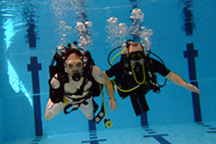To enrol on the BSAC Advanced Diver course with Southsea Sub-Aqua Club, you must:
- be 14 years or older
- be a current full diving member of both the BSAC and Southsea Sub-Aqua Club
- be considered "fit to dive"[1] and have completed the Dive Leader course or equivalent (i.e. Dive Master).
- prior to completing this qualification, the candidates must have completed twenty dives in a range of conditions, since qualifying as a Dive Leader (or equivalent), with an additional 600 minutes dive time
- in addition to the number of dives, the Advanced Diver candidate must also show a range of diving experience that will include the following:
- planned decompression dive - dive involving at least two planned decompression stops, of a total of at least 6 mins, using an appropriate equipment configuration and decompression technique
- dive in tidal waters - dive involving a direct descent following a shot line, to dive on a specific site in a slack water window. Ascent either via shot line or under DSMB as appropriate to tidal conditions at end of dive
- drift dive - dive to a minimum depth of 15m in water moving at a speed that precludes a return to the point of entry
Only one of the above conditions may be logged per dive.
In addition to the above, a further six dives should include at least three of the following conditions:
- navigation dive - dive requiring navigation around a site, involving multiple changes of direction throughout and returning to the entry point. Compass and/or pilotage/and/ or distance line techniques used as appropriate. Minimum duration 30mins.
- search dive - A dive involving the utilisation of underwater search techniques.
- no clear surface dive - A dive involving no clear surface, either cavern, wreck penetration or ice diving.
- mixed gas dive - A dive involving the use of mixed gas, (Nitrox alone does not qualify) either closed circuit rebreather or open circuit.
- advanced decompression dive - A dive involving extended decompression at different depths and emergency gas deployment using either a decompression trapeze or a lazy shot.
- surface location dive - A dive involving the surface location of an unknown site using surface searching techniques, followed by suitable precautions when diving an unknown site.
- Of the twenty dives:
- at least ten should be carried out from boats. Of these, at least three should be carried out from boats of at least 9m in length, and at sites in exposed locations with surface water conditions producing significant boat motion
- on at least ten the student should act as dive leader
- at least six should show depth experience greater than 30m
- on at least five occasions the student should act as Dive Manager (including taking responsibility for carrying out all planning activities):
- at least two should be full-day diving activities, to sites that are unknown to the student Dive Manager (Note; Practical lesson AP2 may qualify as one of these)
- at least one should be for a duration of at least two days, involving the need for organising logistics and suitable accommodation, as well as planning and management of the diving activities, including site location. (Note: this should follow after completion of practical lesson AP1)
- the remaining two may be to either known or unknown sites
- At least 6 should show experience of dives to greater depths than those suggested for skills training, and to be adventurous
If you would like to speak to our Training Officer about starting this course, please speak to them on a club night or send them an email: This email address is being protected from spambots. You need JavaScript enabled to view it.
You can read more about this course on the BSAC Website.
![]() Previous page (Definition of an Advanced Diver)
Previous page (Definition of an Advanced Diver)
Next page (Dive Gear) ![]()
![]() Return to Advanced Diver Course Introduction...
Return to Advanced Diver Course Introduction...
![]() Return to Training Page...
Return to Training Page...
[1] "Fit to dive" is assumed on the basis of a completed Self Certification Medical Form or a Certificate to Dive issued by an approved Medical Referee.



